RBA Annual Conference – 2016 The Changing Role of the Private Sector in China Nicholas Lardy[*]
- Download 242KB
1. Introduction
The relative roles of state and private firms, indeed the relative importance of the state more broadly, in explaining China's rapid economic growth in the past four decades continues to be debated. I have previously argued that the expanding scope of markets, and the growing role of private firms operating in these markets, has been a major (if not the major) source of economic growth in the reform era (Lardy 2014). The role of markets in China has certainly expanded since the early 1980s. China has moved from a system in which almost all important prices were set administratively, with scant attention to underlying supply and demand, to one in which markets determine the prices of virtually all goods and services and, more recently, most factors of production as well. In this increasingly market-driven environment, private firms have become the dominant source of the growth of output, employment and exports. On the other hand, other studies have emphasised the continued centrality of state planning and state-controlled firms (U.S.-China Economic and Security Review Commission 2015). This paper summarises the views expressed in my earlier work, assesses whether private firms have continued to expand relatively rapidly since 2012 and explores what this implies for China's growth in the future.
2. State and Private Enterprises in China
The distinction between the state and private sectors is not straightforward in China, so it is useful to define each of these categories. The universe of state firms began to expand from the more traditional state-owned firms after the passage of the 1993 Company Law, which allowed the formation of various types of shareholding companies, such as limited liability companies and shareholding limited companies (the latter sometimes translated as joint-stock companies). As a result, a growing number of traditional state-owned companies converted to become limited liability or shareholding limited companies. A significant subset of these firms listed on equity markets, meaning that the extent of state ownership of these firms was diluted. That gave rise to the concept of state-controlled companies, shareholding companies in which the state is the sole, majority, or dominant owner (Lardy 2014, pp 47–48) (Table 1).
| Description | Number of firms | |
|---|---|---|
| State-owned firms
(全民所有制企业 or 国有企业) |
Enterprises owned by the people | 133,132 |
| State-controlled firms | Limited liability or shareholding firms in which the state is the sole, majority, or dominant owner | 130,216 |
| Absolutely state-controlled | The state has contributed 50 per cent or more of the paid-in capital or capital stock | |
| Relatively state-controlled | The state has contributed less than 50 per cent of the paid-in capital or capital stock but has contributed more than any other single shareholder | |
| Consultatively state-controlled | Those in which the state's capital contribution is less than that of one or more other shareholders, but in which the state exercises control by virtue of agreement with these other shareholders | |
|
Source: Lardy (2014) |
||
Throughout this paper, data on output and investment of state companies includes the broad universe of traditional state companies plus shareholding companies that are state controlled. In addition, investment in all projects undertaken by public institutions (事业单位) and state administrative units ‘(行政单位)’ are included within the scope of state-controlled investment (NBS 2016a). In contrast, the data on private companies is limited to registered private companies and does not include shareholding companies that are privately controlled, with the exception of the data on investment and bank credit. In 2014, there were 7.26 million registered private companies and 1.77 million privately controlled limited liability companies (NBS 2015, pp 22–23). However, the return on assets and the returns of private registered companies are arguably good proxies for the broader universe of private companies (Lardy 2014, p 97, fn 52).
3. The Record to 2012
3.1 Output
The state's share of output declined across a range of sectors since the late 1970s. Agricultural production, but not formal land ownership, was privatised early in the reform era. The direct role of the state in farm production is now limited to state farms, and accounted for only 1 per cent of the agricultural labour force and 3 per cent of the value of farm output in 2011 (Lardy 2014, p 62). The state continues to have a dominant role in the provision of rural infrastructure, since it undertakes and finances almost all investment in irrigation projects.
In the industrial sector, which includes manufacturing, mining and utilities, state-owned firms accounted for almost 80 per cent of the value of gross industrial output in 1980. By 2011, this share had shrunk to just 25 per cent. In manufacturing, which accounts for the majority of industrial output, the share of output produced by state firms had declined to only 20 per cent by 2011. The state share of production in mining, and particularly in utilities, has remained much more elevated (Lardy 2014, p 75).
The decline in the role of state firms in construction is similar to that in the industrial sector. In 1980, state firms accounted for around three-quarters of both the value of construction and employment in the sector. Collective construction firms, which were typically owned by, or had close links with, local governments, accounted for the remainder of both employment and construction value. By 2010, the share of construction value contributed by state and collective firms had fallen to less than 40 per cent; the balance was the result of construction activity by private firms (Lardy 2014, p 79).
In the services sector, there are no comprehensive data on the share of value added by state and private firms. However, there is limited information available for some of the components of the services sector. For wholesaling and retailing, historically the largest component of the services sector, the data are very clear. Private firms accounted for 0.1 per cent of both wholesale and retail sales in 1978, but expanded their shares to half of both categories by 2008 (Lardy 2014, pp 80–81). The transformation was similar in catering, where private firms accounted for only 7 per cent of employment initially, but expanded to 80 per cent of employment and two-thirds of catering revenue by 2008 (Lardy 2014, p 81). The state retained substantial limitations on entry by private firms into services other than wholesale, retail and catering. Restrictions were particularly severe in modern business services such as information transmission, software and information technology; financial services; business and leasing services; and scientific research and technical services. Furthermore, as is the case in most market economies, the state has continued to play a dominant role in the provision of services such as education, health, and public management.
3.2 Employment
China's aggregate employment data are among the most problematic for two major reasons.[1] First, it is difficult to obtain an accurate split between state-owned and private firms in the employment data. The Ministry of Human Resources and Social Security continues to publish data almost exclusively on the basis of the registration status of firms, whereas most Chinese agencies now publish data disaggregated by ownership (based on the concept of control).[2] For example, employment data are available for shareholding companies, but within this category there is no split between privately and publicly controlled firms.
The second problem with official employment data is that the disaggregation of the number of workers into various registration categories is incomplete. If one adds up all of the official urban employment data for 2011 by registration status (including data on the self-employed) the sum falls 96.8 million workers short of the reported 359.1 million urban workers (NBS 2012, p 125). This discrepancy arises because total urban employment is estimated based on the most recent national population census and an annual labour force sample survey, whereas data on employment by registration status are based on reporting by enterprise units. These employment data reported by enterprises exclude informal urban workers who do not have stable employment contracts, do not make contributions to various social insurance funds and do not receive social benefits.
Using more granular data from a variety of sources, I have constructed a time series of employment in the private and public sectors. I estimate that employment by private firms in urban areas has expanded from 150,000 (0.2 per cent of urban employment) in 1978 to 253 million (about two-thirds of China's urban labour force) in 2011. More impressively, the growth of urban private employment is estimated to have accounted for 95 per cent of the growth of the urban workforce between 1978 and 2011 (Lardy 2014, pp 84–85). On the other hand, employment in state-owned and state-controlled companies declined from 59.8 million (just over one-quarter of the urban workforce) in 1999 to 45.1 million (12.5 per cent of the urban workforce) in 2011.[3]
In summary, this analysis strongly supports two broad conclusions with respect to employment since reform began. First, the growth of the private sector accounts for virtually all of the growth of urban employment between 1978 and 2011. Second, employment in state-owned and state-controlled companies has declined significantly since the late 1990s, not only as a share of the urban workforce but also in absolute terms.
3.3 Exports
Another indicator of the rise of the private sector and shrinkage of the economic role of state firms is the evolution of the sources of China's exports. In the mid 1990s state firms produced about two-thirds of China's exports and foreign affiliates about one-third. By 2013, the share of state firms had fallen to just 11 per cent; the foreign affiliate share rose to almost to 60 per cent by the middle of the 2000s and then fell to 47 per cent by 2013. Private firms, which were not in the export space at all in the 1990s, were producing 39 per cent of China's exports by 2013 (Lardy 2014, pp 86–88).
4. Explaining the Rise of the Private Sector
At least three important factors explain the rise of China's private sector: the evolution of state policy; the greater efficiency of private firms; and the increasing commercialisation of the financial sector.
In the early years of reform, the policy environment and legal framework for private non-agricultural businesses was basically hostile. A constitutional amendment passed by the National People's Congress in 1978 authorised family businesses, but regulations restricted employment to no more than seven non-family members. The government did not promulgate regulations allowing private corporations until 1988, a full decade into the reform process, and even then only allowed private sole proprietorships. The absence of limited liability tended to restrict the size of these firms. The possibility of limited liability companies was introduced by the 1993 Company Law, but single person limited liability firms were not legal until the Company Law was amended in 2006 (Lardy 2014, pp 89–92).
The state expanded the scope of businesses open to private firms only gradually. Family businesses were quick to take advantage of the early opening of opportunities in retail, catering and construction, but private entry into manufacturing was initially slower. And, as discussed above, key parts of the economy are still reserved for state companies.
The second key explanation of the rise of the private sector is the higher productivity of private firms. These firms have consistently generated higher rates of growth of total factor productivity that, in turn, have been reflected in a higher return on assets. This was not so important in the 1980s, when a large share of investment was financed through the state budget and channelled mostly to state-owned firms. But reforms put into place in the 1980s allowed firms to retain a growing share of their profits and, as a result, the share of investment financed through the budget shrank dramatically. By 1997, for example, only 3 per cent of the investment of industrial firms was financed through the state budget (Naughton 2007, p 304). More broadly, the share of investment by non-financial corporations financed from retained earnings grew significantly over time, reaching an average of about 70 per cent in the years from 2000 to 2008 (Lardy 2014, p 96). Private firms on average generated much higher return on assets, meaning they had larger retained earnings relative to the size of the assets they controlled. These profits were mostly reinvested, thus the assets of these firms grew more rapidly than state firms, in turn generating faster output growth. This is the fundamental process that led to the gradual decline in the share of output produced by state firms in the domains of China's economy that were open to private firms.
The third key factor underlying the growth of the private sector is the increasing commercial nature of bank lending. Through the mid 1990s the financial system was dominated by four large state-owned banks that lent predominantly to state-owned companies. In the mid 1990s, loans to state-owned companies accounted for 60 per cent of renminbi-denominated loans outstanding extended by all financial institutions (Lardy 1998, p 83). This share fell to only 30 per cent by the end of 2012 (Lardy 2014, p 107). While detailed data on lending to enterprises disaggregated by the ownership status of the borrower have become available only in recent years, the share of the annual increase in loans outstanding to state-owned and state-controlled enterprises has fallen from 48 per cent of all loans to non-financial enterprises in 2010 to 35 per cent in 2013 (China Banking Society 2014, pp 341–342; Lardy 2014, p 105). I believe that this increase in the share of loans flowing to private enterprises largely reflects the fact that private firms, on average, are more creditworthy than state firms. This is confirmed by a common metric of creditworthiness, the interest coverage ratio, which is simply the ratio of a firm's earnings before interest and taxes to its interest expense. In the industrial sector, where this ratio can be calculated from official data, private firms have been twice as creditworthy as state firms in recent years (Lardy 2014, p 110). No doubt state banks, particularly the largest ones, are sometimes required to lend money to support state-owned firms, but they apparently have some flexibility and a growing share of bank lending is undertaken by smaller shareholding banks and city commercial banks that direct a much smaller share of their loans to state-owned firms. As a result, an increasingly larger share of corporate loans is going to private firms.
5. Recent Developments
The rising importance of the private sector in output, employment and exports through the Hu Jintao-Wen Jiabao era is fairly clear. What about more recently? Have long-term trends continued, faltered or even reversed?
In recent years, there has been an acceleration in the formation of private enterprises, both registered private companies and limited liability companies that are privately controlled (Table 2). The increase in the number of limited liability companies was particularly noticeable in 2013 when the minimum capital requirements to register a limited liability company, an individual limited liability company or a shareholding limited company were eliminated (Lardy 2014, p 145). In addition, the number of workers employed in individual family businesses (个体工商户), which are not classified as enterprises, continue to expand. In China's labour statistics, workers in these businesses are classified as self-employed. In urban areas, the number of self-employed workers expanded from 150,000 in 1978 to some 56 million by 2012 and then expanded by an additional 25 per cent in the ensuing two years, reaching 70 million by the end of 2014 (Lardy 2014, p 83; NBS 2015, p 112). The number of rural, non-agricultural, self-employed workers has also continued to rise in recent years.[4]
| Registered private companies | Privately controlled limited liability companies | |
|---|---|---|
| 2010 | 4,683,851 | 442,587 |
| 2011 | 5,254,870 | 537,232 |
| 2012 | 5,917,718 | 634,331 |
| 2013 | 5,603,917 | 1,456,079 |
| 2014 | 7,266,188 | 1,761,500 |
The financial performance of state firms relative to private firms continues to be very weak, particularly in the industrial sector. Private firms have recorded much stronger growth of profits in recent years, a trend that was even more obvious in 2015 when the profits of all above-scale industrial firms fell by 2.3 per cent. But for state firms, the fall was much sharper at 21.9 per cent. In contrast, profits of private firms rose by 2.3 per cent. As a result, in 2015 the profits of private industrial firms were CNY2.32 trillion, more than twice those of state firms at CNY1.09 trillion (NBS 2016b).[5]
The same conclusion can be drawn by looking at official data on return on assets of state versus private industrial firms (Figure 1). Returns for both types of ownership have fallen as industrial growth has moderated in recent years, but the returns of private firms continue to be almost three times those of state firms.
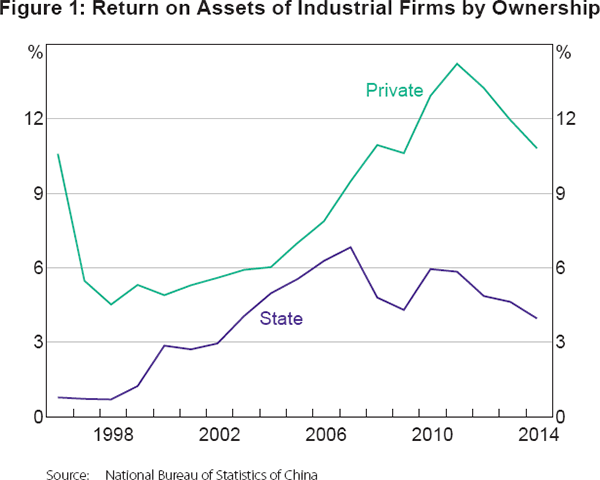
The relative inefficiency of state industrial firms is also reflected in other financial data related to the rapid build-up of debt in China since the global financial crisis. While the debt-to-GDP ratio has soared, including a huge increase in the debt of industrial firms, this has not resulted in a noticeable increase in the leverage ratio (the ratio of liabilities to equity) of these firms (Figure 2). The leverage ratio was relatively flat for the decade to 2013 and has since fallen. When we disaggregate this universe of firms by ownership, however, a very different picture emerges. The leverage ratio of state industrial firms has risen significantly since 2007, meaning that their liabilities are growing much more rapidly than their equity. This is consistent with the relatively low return on assets earned by these firms. Private industrial firms, on the other hand, show a very different picture. As noted earlier, private firms borrow more from the banks than state firms, but they generate much higher returns, in turn leading to higher retained earnings. These earnings are reinvested so that the equity of these firms grows more rapidly than their liabilities, and therefore, in aggregate, the leverage ratio of these firms is declining.
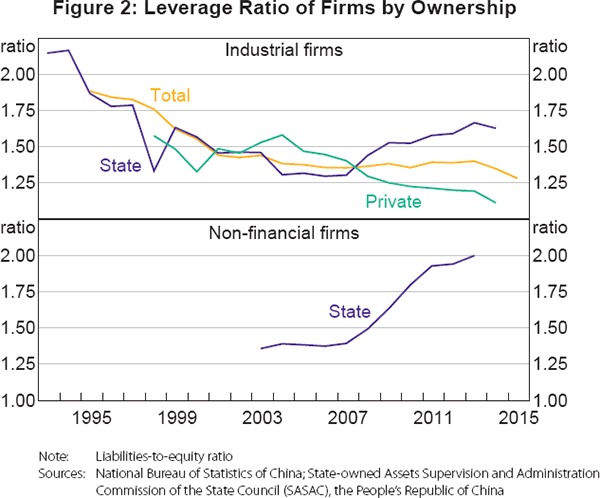
An even starker picture emerges when the services sector and local government platform companies are included. The leverage ratio of all state firms has risen much more rapidly and is substantially higher, at around 200 per cent in 2013. The picture that emerges is consistent with the hypothesis that the growth of borrowing by state companies is explained increasingly by their need to roll over their previous borrowings (including capitalising the interest payments due on these prior loans) and to finance wage payments, social security contributions and pay for inputs, rather than by their exploitation of profitable investment opportunities. In short, there appears to be a significant subset of state firms that fall into the category popularly known as zombie firms.
Turning to the question of the evolving relative importance of state as opposed to private firms, data considerations make the analysis of trends in output by ownership easiest in the industrial sector.
The contribution of state firms to industrial output continued to shrink after 2011. The output of private firms, as measured by value added, has grown on average over twice as fast as state firms throughout this period (Figure 3).[6] This margin widened further in 2015 when overall industrial value added expanded by 6.1 per cent; state firms barely grew at all, expanding by only 1.4 per cent and private firms expanded six times as fast. The declining role of state firms in industry is also reflected in data on investment by ownership (Figure 4). By 2014, private firms accounted for 77 per cent of investment in manufacturing, up 3 percentage points from 2012, while the share of state firms slid to only 8 per cent, down from 11 per cent in 2012.
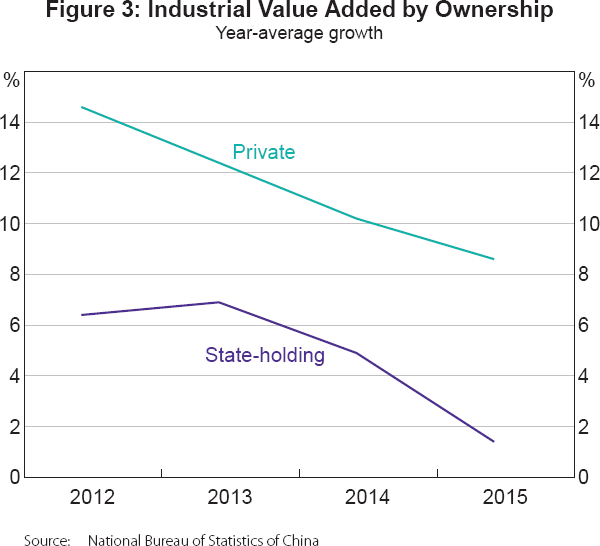
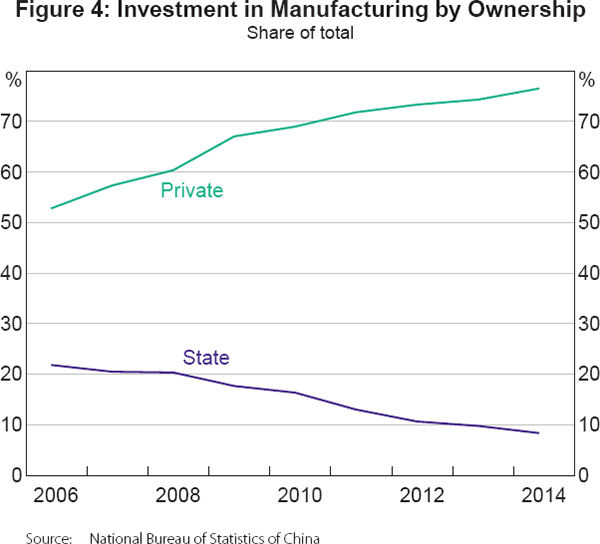
State firms continue to be a far more important source of investment in the other components of industry. In 2014, state firms accounted for 45 per cent of investment in mining (which includes upstream oil and gas) and 66 per cent of investment in utilities (NBS 2015, pp 322–323).
Data on value added, disaggregated by ownership for the various components of the services sector, continue to be extremely limited. Detailed results from the 2013 economic census, a source that would probably have a breakdown of private and state output for most of the components of the services sector, are not yet available.[7] In the absence of such data, the best indicator of the evolving role of private and state ownership in the services sector is investment. As already noted, the role of the state and state firms in services sector investment has eroded much more slowly than in industry. By 2012, the state still accounted for 45 per cent of all investment in services, twice their share of investment in industry and four times their share in the manufacturing component of industry. While private firms had largely displaced state firm investment in wholesale & retail trade and catering, the state continued to dominate investment in transportation, health, education and public management, where its share of investment remained between two-thirds and three-quarters.
Overall the state share of investment in services continued to erode slowly after 2012, reaching 43 per cent in 2014. This small additional erosion was largely because the share of private investment in modern business services continued to rise significantly (Figure 5). The 10 percentage point rises between 2012 and 2014 in the shares of private investment in the categories of information transmission, software and information technology; financial intermediation; and scientific research and technical services are particularly noticeable. The effect of expanding private investment in these domains on the total share of state investment in services, however, is modest since the share of these three components in total services investment is relatively small.[8]
While the contribution of state firms to industrial output continues to erode, these firms' share of China's exports through 2015 held steady at 11 per cent. The share of exports produced by foreign affiliates fell 3 percentage points to hit 44 per cent between 2013 and 2015, while the share produced by private firms rose 4 percentage points to reach 43 per cent over the same period. Thus, private firms continue to be the dominant source of the growth of exports, a position they have had since 2009.
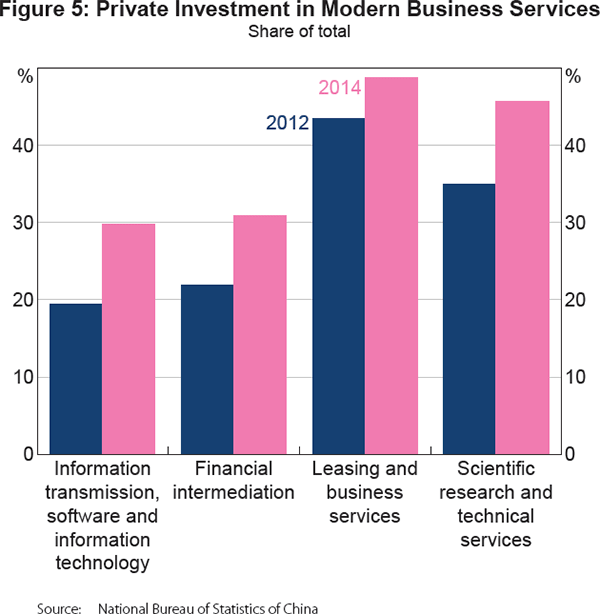
While the contribution of state firms to industrial output continues to decline, the shares of both services sector investment and overall fixed asset investment undertaken by the state and state firms have declined only slightly since 2012 (Figure 6). This is a sharp change in the historical pattern. The share of state investment was 82 per cent in 1980 (Lardy 2014, p 115). After declining for three decades at an average pace of 1½ percentage points, why has the pace of decline in the state share of investment moderated to only about two-thirds of a percentage point in recent years? There are several, non-mutually exclusive, possible explanations.
The first is that, by 2012, private firms had already taken advantage of most of the liberalisation of entry that the state has allowed over the years, and a further significant increase in the share of investment undertaken by private firms would require eliminating or substantially reducing the barriers to entry that constrain private firms in key parts of the economy. In the sector where entry has been the most liberalised for the longest period of time, wholesaling and retailing, as well as manufacturing, the share of state investment now is under 25 per cent and 10 per cent, respectively (NBS 2015, pp 322–325). But in other domains the state continues to highly restrict entry by private firms and the share of investment undertaken by state firms is quite high. For example, in 2014, the state accounted for 92 per cent of investment in upstream oil and gas, 70 per cent of investment in electric power generation, and 96, 86, and 73 per cent of investment in rail, air, and pipeline transport, respectively (NBS 2015, pp 322–323).
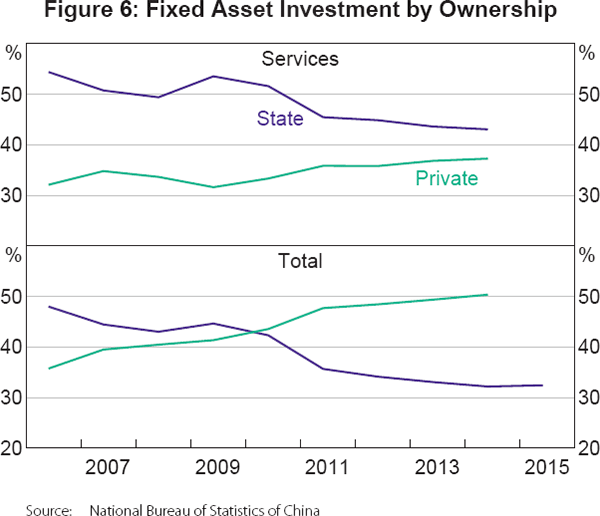
A second explanation is that a significant share of the state's investment in services is in domains in which the role of the state is high not only in China but in most market economies as well, such as health, social security and social welfare; management of water conservancy, environmental and other public facilities; education; and public management. While there has been a very modest increase in private investment in education and health in recent years, state investment is likely to continue to be very dominant in these domains.
A third possible explanation is that as China's growth has moderated in recent years and profit-oriented private firms see fewer attractive investment opportunities, so their share of investment has levelled off.
A fourth possible explanation of the very slow pace of reduction in the share of investment attributed to the state is the heightened role of infrastructure investment, a large share of which is undertaken by the state. Sharply rising infrastructure investment raised the share of state investment slightly in 2009 (Figure 6). These expenditures continue to rise more rapidly than overall investment, and thus have sustained the state share of investment above the level that otherwise would have occurred.[9]
6. Conclusion
A major source of China's growth in the reform era has been the increasing share of investment undertaken by private firms that have been able to generate a return on assets as much as three times that of state firms. Two recent trends are worrying. First, the rate of expansion of the share of investment undertaken by private firms has moderated dramatically to a pace far below the first three decades of economic reform. Part of this is probably due to the moderation in China's economic growth that has slowed the pace of investment growth by more profit-oriented private firms. But it seems likely that the slow pace of reduction in barriers to entry by private firms in critical domains is also a significant factor.
The second worrying trend is that the productivity gap between the state and private sectors has widened substantially over the past decade, largely because the return on assets of state companies declined precipitously beginning in 2008, while return of private firms continued to rise through 2011 and then fell more modestly. The net result has been that the returns of state firms since 2007 (with the single exception of 2010) have been persistently below the cost of capital (Lardy 2014, p 126).
Both these trends have contributed to the slowdown in China's growth that has been evident over the past few years. The rising productivity gap also helps to identify what should be the real source of concern associated with the rapid rise in the ratio of debt to GDP in China over the same period – the rapid increase of indebtedness of state-owned companies.
Footnotes
The services sector figures quoted above do not suffer from the same issues as the aggregate data. [1]
Much of the employment data included in the annual China Statistical Yearbook is compiled by the Ministry of Human Resources and Social Security rather than the National Bureau of Statistics of China. [2]
Even this time series is problematic because of a reclassification of public institutions into enterprises (事业单位企业化). Starting more than five years ago, public institutions such as publishing houses, state guest houses and other institutions with obvious revenue streams were reclassified, presumably as part of an effort to reduce the flow of public fiscal funds supporting these units. Thus, the data for more recent years are not strictly comparable with those for earlier years and the time series I have constructed understates the decline in employment in state enterprises. [3]
The number of rural self-employed individuals is only about half the number of urban areas, presumably because a large share of rural individuals wishing not to engage in agriculture have become migrant workers. [4]
These figures understate the difference in absolute profits of state and private industrial firms for two reasons. First, the figures for state firms include shareholding companies in which the state is the sole, majority, or dominant owner while the profits of private firms are for registered private firms only and thus do not include profits of privately controlled shareholding companies. Second, the data include only the profits of firms with annual revenue over CNY20 million. State firms on average are much larger than private firms so this threshold excludes a relatively larger share of private than state firms. [5]
The average annual growth of value added for private firms in 2012–15 was 11.5 per cent; for state firms 4.9 per cent. [6]
The previous economic census provided data on assets and profits disaggregated by ownership for 10 of the 14 components of the services sector. [7]
In 2014, investment in these three components of the services sector accounted for only 3.5 per cent of all investment in services. [8]
For example, in 2015, infrastructure investment rose 17.2 per cent; overall investment rose 10.0 per cent. Infrastructure investment accounted for almost a fifth of all investment (NBS 2016a). [9]
References
China Banking Society (2014), Almanac of China's Banking and Finance 2014 (English Version), China Financial Publishing House, Beijing.
Lardy NR (1998), China's Unfinished Economic Revolution, Brookings Institution Press, Washington DC.
Lardy NR (2014), Markets over Mao: The Rise of Private Business in China, Peterson Institute for International Economics, Washington DC.
Naughton B (2007), The Chinese Economy: Transitions and Growth, MIT Press, Cambridge.
NBS (National Bureau of Statistics of China) (comp) (2012), China Statistical Yearbook 2012, China Statistics Press, Beijing.
NBS (comp) (2015), China Statistical Yearbook 2015, China Statistics Press, Beijing.
NBS (2016a), ‘2015 年全国固定资产投资 (不含农户) 增长 10%’ (2015 National Investment in Fixed Assets (Excluding Rural Households) Increased by 10%), Press Release, 19 January. Available at <http://www.stats.gov.cn/tjsj/zxfb/201601/t20160119_1306141.html>.
NBS (2016b), ‘2015 年全国规模以上工业企业利润总额比上年下降 2.3%’ (2015 National Total Profits of Industrial Enterprises above Designated Size Decreased by 2.3% over the Previous Year), Press Release, 27 January. Available at <http://www.stats.gov.cn/tjsj/zxfb/201601/t20160127_1310925.html>.
U.S.-China Economic and Security Review Commission (2015), 2015 Report to Congress of the U.S.-China Economic and Security Review Commission, U.S. Government Publishing Office, Washington DC.